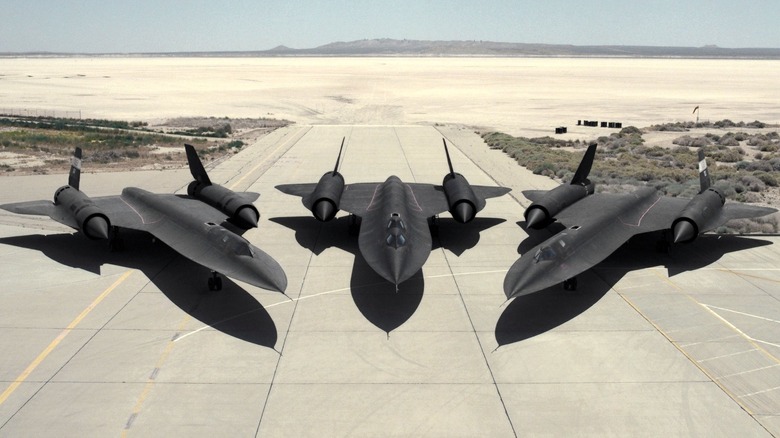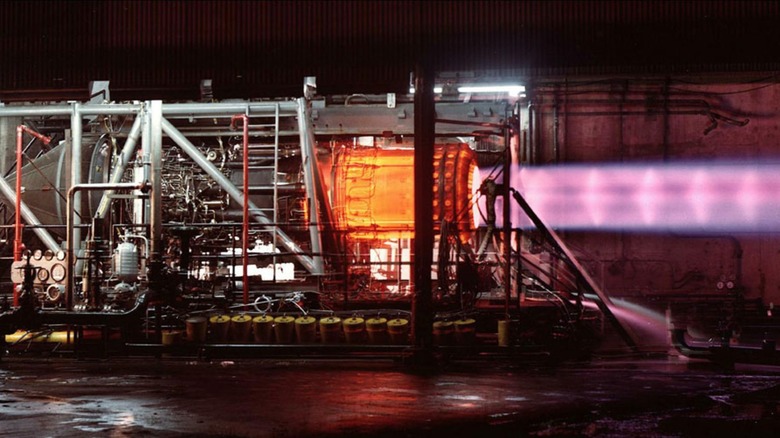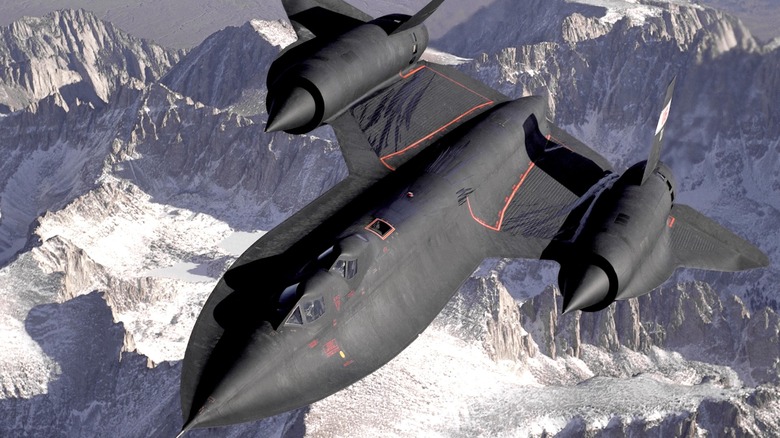SR-71 Blackbird: What Is The Top Speed Of The World's Fastest Jet?
The SR-71 is one of the U.S. Air Force's most prolific aircraft. Other than looking like a futuristic aircraft military model lovers have built for decades, it was designed and built in secret by the famed Lockheed Skunk Works division. Moreover, the SR-71 was fast — very fast. Skunk Works built it for speed to accomplish its primary mission, which was intelligence, surveillance, and reconnaissance (ISR) primarily directed at the Soviet Union. The idea was to develop a spy plane capable of flying as high as 85,000 feet at Mach 3.3 (2,193.2 mph), which made it nearly immune to Soviet anti-air defenses.
If a surface-to-air missile (SAM) radar site found the spy plane, by the time it fired a missile to intercept, it was already out of range. When it entered service in 1966, the SR-71 was unparalleled as one of the highest-flying military jets to take to the skies. It continued serving the U.S. Air Force until 1990 but was also utilized by NASA until 1999.
The aircraft was incredibly expensive to maintain and has to be retired due to budget costs, and operating one required a great deal of preparation due to its complexity. In total, 32 Blackbirds were built, and while none succumbed to enemy air defenses or other actions, 12 were lost in accidents. Ultimately, the SR-71's most noteworthy factor was its speed. It's hard to imagine what pilots went through careening through the sky at more than three times the speed of sound.
The incredible speed of the SR-71
The SR-71's development required several innovations in both engine and fuel design. Lockheed outfitted the Blackbird with two Pratt & Whitney J58 turbojet engines, which were built for high Mach speeds and also used in the A-12 and YF-12. The engines' development began in 1958, when it was intended for a Navy reconnaissance plane. Instead, they went into the Air Force's SR-71 after the Soviet Union shot down a U-2 spy plane. Since the SR-71 was meant to exceed Mach 3, the J58 served it well.
Typically, the military uses the same kind of fuel — today, it's JP-8 — but the SR-71 required JP-7 to function as desired. JP-7 was developed to have a higher flash point than other jet fuels, ensuring the Blackbird didn't burst into flames from the high temperatures caused by the intense friction generated by flying at extreme speeds.
This worked well, and when a pilot fired up the engines to maximum thrust, the SR-71 shot through the sky at more than 2,000 mph. Air Force Colonel Jim Wadkins compared flying the Blackbird at max speed to something spiritual, saying, "At 85,000 feet and Mach 3, it was almost a religious experience," according to Lockheed Martin. He continued, "Nothing had prepared me to fly that fast... My God, even now, I get goose bumps remembering." And the spy plane would break record after record throughout its development.
The SR-71 speed records that have yet to be broken
The SR-71 set several impressive records related to its speed, highest flight, and quickest travel between two points. In 1974, an SR-71 set a world record by flying from New York to London. It flew at 80,000 feet in excess of 2,000 mph and made the flight in one hour, 54 minutes, and 56.4 seconds. That same year, an SR-71 set another distance speed record by flying from London to Los Angeles, covering 5,447 miles in three hours, 47 minutes, and 30 seconds.
In 1976, an SR-71 achieved an absolute speed record for a manned aircraft, achieving Mach 3.3 (2,193.2 mph), though another pilot, Brian Shul, wrote in his book, "The Untouchables," that he exceeded Mach 3.5 in 1986 while evading a Libyan air defense missile, though this claim hasn't been verified. If true, he would have flown his SR-71 at approximately 2,685.4 mph. Another record set in 1976 involved an SR-71's highest operational flight, which topped out at 85,069 feet, setting an absolute altitude record.
On June 6, 1990, the final flight of the SR-71 for the U.S. Air Force set four as-yet unbroken records: it flew from Los Angeles to Washington, D.C., in 64 minutes and 20 seconds. It also went from the West Coast to the East Coast of the United States in 67 minutes and 54 seconds. The aircraft set another distance record, flying from Kansas City, Missouri, to Washington, D.C., in only 25 minutes and 50 seconds, and finally, it flew from St. Louis to Cincinnati, Ohio, in eight minutes and 32 seconds.


